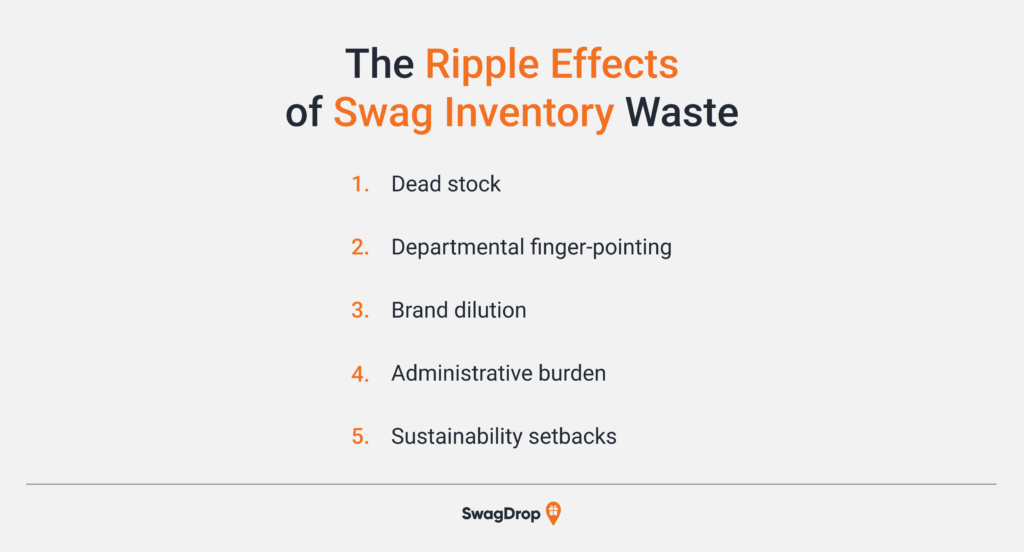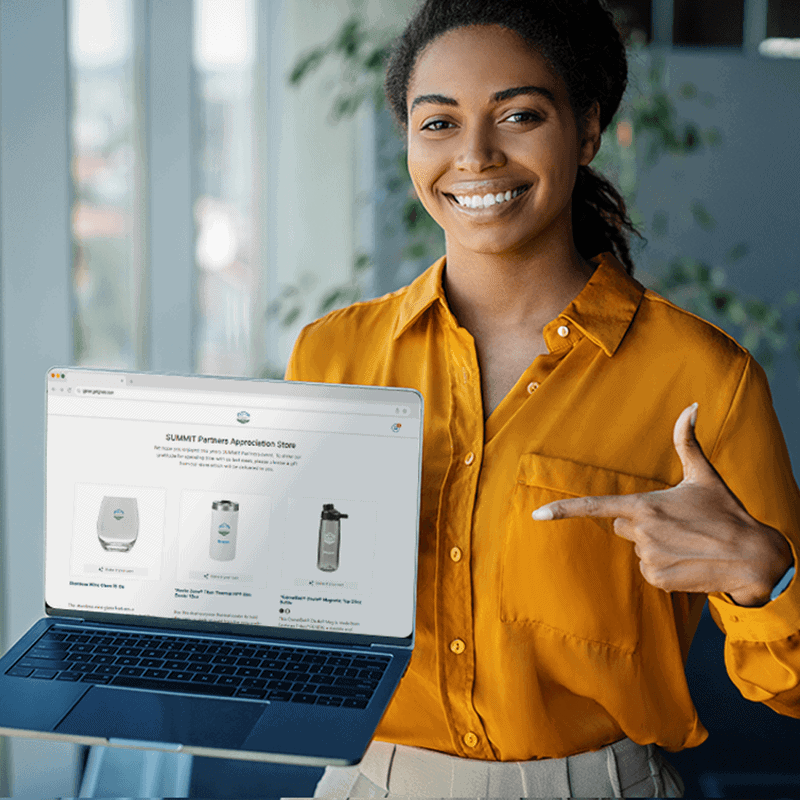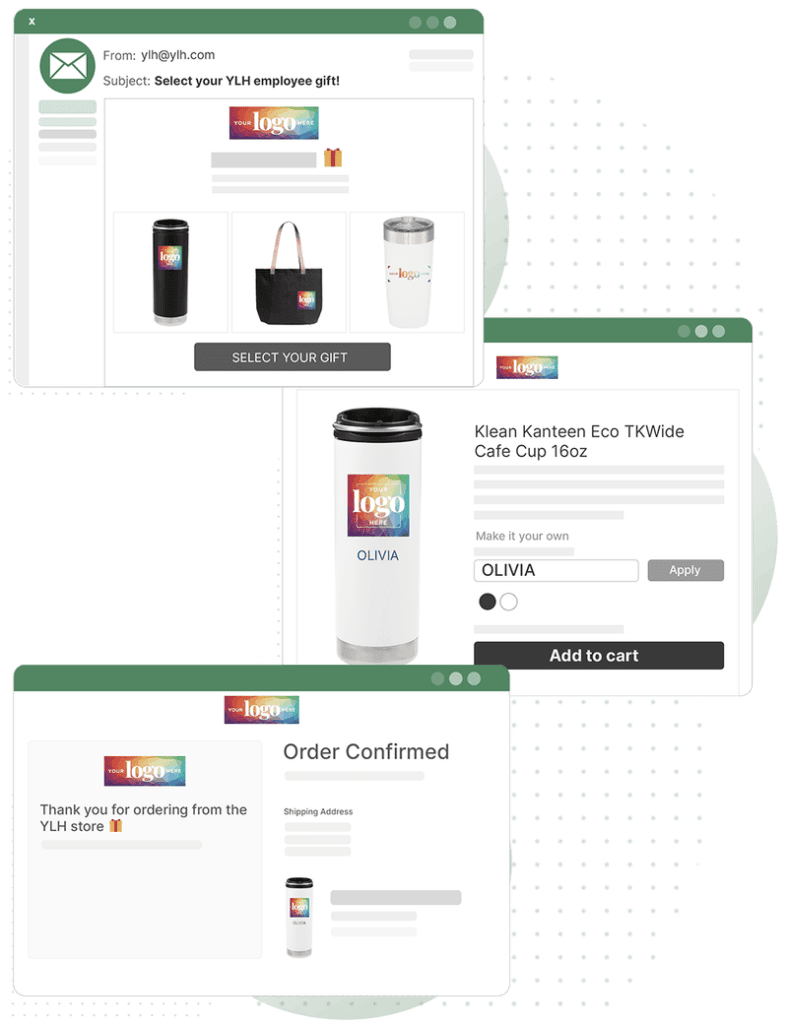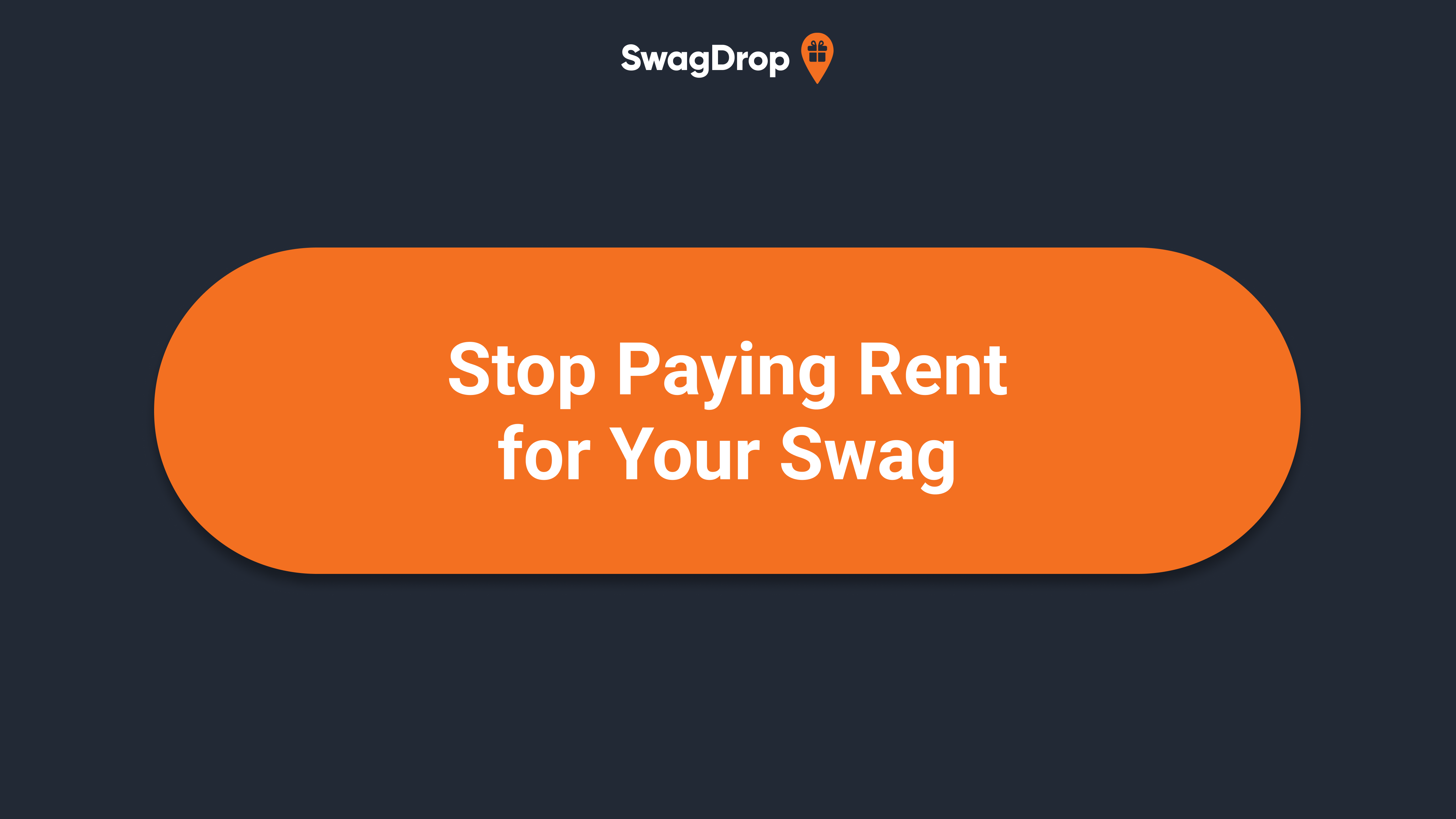Companies pour thousands or even millions of dollars into branded products to inspire loyalty, engage employees, or impress clients.
Yet, the true price of swag doesn’t end with the initial order.
Bulk buying comes with the ongoing costs of warehousing, organizing, and maintaining promotional products for months or even years.
In other words, you start paying “rent” on your own merchandise, chipping away at your marketing budget and limiting your ability to invest elsewhere.
This guide pulls back the curtain on the real financial toll of long-term swag storage and shows you a smarter way forward.
Let’s get the ball rolling!

Table of Contents
The Hidden Costs of Bulk Swag and Storage
The Ripple Effects of Swag Inventory Waste
The Hidden Costs of Bulk Swag and Storage
Buying branded merchandise in bulk feels efficient. You get volume discounts, and you have products on hand whenever a campaign or event pops up.
Unfortunately, this logic can backfire.
What companies told us
At SwagDrop, we often hear from companies looking for better ways to manage and distribute their promotional products. Through these conversations, we’ve uncovered some eye-opening examples of just how costly pre-purchasing swag in bulk can be:
- One marketing team revealed they invested $150,000 in items employees and clients didn’t want, forcing them to quietly dispose of the products to avoid harming their brand image.
- Another company admitted they had $50,000 worth of merchandise sitting idle, which they eventually gave away at trade shows and recruiting events just to free up space.
- In one of the most challenging cases, a business was holding $2.5 million in unused swag inventory, a figure that would make any CFO take notice.
The cost you don’t see
The financial implications extend far beyond the value of the unused swag. Every box and pallet of branded products stored in a warehouse incurs monthly bills. You’re essentially paying rent on items you already own, and that rent piles up faster than most companies realize.
According to Lokad, inventory carrying costs alone typically equal 25% of the total inventory value each year. Therefore, a $100,000 stockpile of branded t-shirts and mugs actually costs closer to $125,000 after a year in storage.
A 2024 research paper written by Gaurav Sharma puts it bluntly:
“The hidden costs associated with inventory issues can significantly impact a business’s financial health. Funds tied up in inventory represent a considerable opportunity cost, as that capital is not available for other potentially lucrative investments or business improvements.
This situation is further exacerbated by storage and handling costs, which increase with the amount of inventory held. […] As products move through their life cycles, the costs associated with holding them change, particularly for items like fashion and technology, which may require rapid turnover to avoid obsolescence. Additionally, inventory being an asset must be insured, and insurance expenses rise with higher stock levels.”
Add to all this the high subscription and fulfillment fees charged by SaaS swag platforms, and there’s almost nothing left of your initial swag budget. For more info, check out our in-depth SwagDrop vs. SaaS cost breakdown.
These financial losses are only the beginning. The ripple effects of unused swag reach far beyond the balance sheet.
The Ripple Effects of Swag Inventory Waste
The financial costs of swag inventory waste are measurable, but the side effects go much deeper.

Let’s take a closer look at these downsides to help you get a clearer picture.
1. Dead stock
In our 30+ years of working in the promotional products industry, we at SwagDrop have observed a common and costly pattern that repeats itself. Companies invest heavily in company swag, only to discover that these items have a much shorter shelf life than expected.
A full-scale rebrand, a subtle logo refresh, or even a minor tagline update can instantly render thousands of pre-purchased products obsolete.
We’ve also worked with enterprises that rebranded multiple times, leaving entire pallets of outdated merchandise sitting in storage.
In these scenarios, businesses have only a few options:
- Write off the loss immediately and put a strain on the company’s budget.
- Distribute obsolete items at random events and confuse recipients with both old and new branding simultaneously.
- Donate the branded products to offshore charities to prevent the old company name or logo from popping up in North America.
- Donate to a local charity to obtain a small tax deduction. However, if those items later appear in a negative context, such as in a controversial viral video, the company’s old branding could harm its reputation.
2. Departmental finger-pointing
If swag becomes dead stock, the responsibility for its cost and management can generate internal conflicts. Here’s why:
- The marketing department typically places the orders, anticipating campaign needs or upcoming events.
- The HR department may order promotional items to distribute as employee rewards or new hire welcome kits.
- The finance department is responsible for tracking inventory as a company asset and accounting for its depreciation.
Therefore, all three departments are to blame, but none of them wants to assume full liability.
These situations can result in tense budget discussions, prolonged approvals for disposal or repurposing, and debates over whose funds should cover the losses.
The friction between teams turns what should have been a positive branding initiative into a source of stress and inefficiency.
3. Brand dilution
Clearing out old swag might feel like a quick fix, but it can damage your brand perception.
Handing out unwanted swag as trade show giveaways or job fair giveaways sends the wrong message to prospective employees, clients, or partners. Instead of demonstrating creativity and care, these items suggest your company is cutting corners.
Poorly timed or irrelevant giveaways can come across as thoughtless, careless with resources, or out of touch with your business’s own standards, cheapening your brand and reducing engagement.
4. Administrative burden
Managing bulk swag is far more complex than simply paying warehouse fees. A marketing or HR manager inside your organization needs to handle multiple logistical tasks, such as:
- Keeping detailed inventory records
- Coordinating with multiple suppliers
- Rectifying shipment discrepancies
- Managing internal requests
- Solving customer or employee complaints about sizes, colors, or missing items
All these responsibilities can become a time-consuming distraction for managers already juggling marketing campaigns, new employee onboarding, and other high-priority projects.
Instead of wasting so much time on swag, your department heads should focus on new strategies, creative work, and employee or client engagement.
5. Sustainability setbacks
Global environmental concerns have made sustainability a top business priority, particularly among younger decision-makers.
According to the Advertising Specialty Institute (ASI), 100% of promo end-buyers ages 25 to 34 say it’s important that the companies they work with offer eco-friendly products.
Unfortunately, many companies still over-purchase unsustainable swag that later becomes obsolete, resulting in both financial and ecological waste.
Every t-shirt, notebook, or water bottle collecting dust in storage represents raw materials and energy that have already been consumed in production, as well as the carbon emissions generated during shipping.
The environmental footprint of unwanted promotional products extends even further once companies discard these unused items. Textiles and plastics often end up in landfills, where they take decades to decompose and release harmful greenhouse gases that pollute the environment.
Fortunately, organizations like SwagCycle help businesses repurpose, recycle, or donate obsolete swag to prevent it from being sent to landfills.
Still, the best way to avoid financial loss and ecological waste is to prevent overstock from building up in the first place, and we have the perfect solution for that.
The Solution: Swag On Demand
Avoid swag storage costs, dead stock, wasted budgets, and sustainability setbacks with our swag-on-demand shops.
Instead of stockpiling promo items in advance, our custom online stores create and ship gifts only when they’re needed.

Here’s how our solution works and why it’s transforming swag management.
Custom stores built around your goals
Every company has unique needs, such as welcoming new employees, running seasonal campaigns, or showing customer appreciation. With swag-on-demand, we design branded online gift shops tailored to your goals, budget, and brand guidelines.

Tell us what you want, and in as little as 24 hours, we can create a mock-up storefront and hand-pick products that fit your requirements. Once your team approves the artwork, you’ll receive a unique link for your employees or clients, allowing them to select their gifts immediately.
If you’re worried this process might take too long, think again! We launched a 1,000-employee gift shop in just one week!
Personal choice for every recipient
Instead of sending the same generic t-shirt or water bottle to everyone, our shops give recipients the ability to choose what suits them best.
Your team members or customers gain access to more than 600 premium products, including everything from branded jackets and cool office supplies to tech swag and travel promotional items.
Recipients can select their preferred size, color, or style, meaning no more sizing mistakes or unused swag sitting in a closet.

This simple alternative turns branded giveaways into a thoughtful, personalized, and fun experience that everyone is going to enjoy and remember.
Zero inventory and zero waste
Traditional swag programs force you to guess quantities, frequently resulting in excess inventory and wasted money.
If you opt for our print-on-demand corporate swag shops, we’ll start producing items only when someone places an order.
This demand-driven approach eliminates the risk of dead stock, reduces environmental impact, and ensures your budget is allocated to products that will actually be used.
Stop paying “rent” on your own merchandise by skipping storage and upfront purchasing and redirecting those funds into more meaningful initiatives.
We’re also glad to inform you that we offer a wide range of eco-friendly promotional products that support global sustainability initiatives, further reducing waste.
Hassle-free fulfillment and shipping
At SwagDrop, we handle everything from product sourcing and production to packing and shipping swag directly to each recipient’s doorstep.
We also send regular order updates to your clients or employees via email and answer all of their questions. Still, only 1% of recipients actually reached out with inquiries in the past year thanks to SwagDrop’s user-friendly interface.
Our end-to-end fulfilment model relieves your HR and marketing managers from the burden of tracking shipments and solving complaints, allowing them to focus on higher-impact projects.
Simple, transparent pricing
Our fee structure is straightforward. We build and design your custom stores at no cost; you only pay for the ordered swag, and shipping is always $9.95 per recipient, anywhere in the USA.

You can also set clear boundaries around your spending. We can curate products within your chosen price range, set item limits for recipients, or provide a fixed amount of gift credits.
This transparent pricing model makes it easy to estimate costs, set realistic swag budgets, and measure the ROI of your corporate gifting programs.
Scalable for campaigns of any size
Our swag-on-demand solution adapts to your business needs, whether you’re sending a small run of gifts to VIP clients or building a large-scale corporate gifting program for your team.
Your stores can remain open in the short term for seasonal campaigns or indefinitely, evolving into permanent e-commerce shops.

No matter the scale, the process remains efficient, predictable, and stress-free.
Of course, we get that some occasions, like big conferences and surprise office parties, still call for ordering swag in bulk, which is why we give you this option too. With our hybrid model, you’re always ready for anything.
Now, let’s wrap things up!
Tips, tricks, and inspiration delivered straight to your inbox.
Stop Paying Rent, Start Creating Impact
Swag should never feel like a liability; yet, too many companies end up paying “rent” on unused merchandise, which drains budgets and generates ecological waste.
Our swag-on-demand model offers a smart and sustainable solution by only producing what your people want, when they want it.
No more waste, administrative headaches, or brand dilution. You can now build authentic connections that drive engagement and loyalty.
Book a call with us today, and we’ll help you create memorable brand moments that truly resonate.


